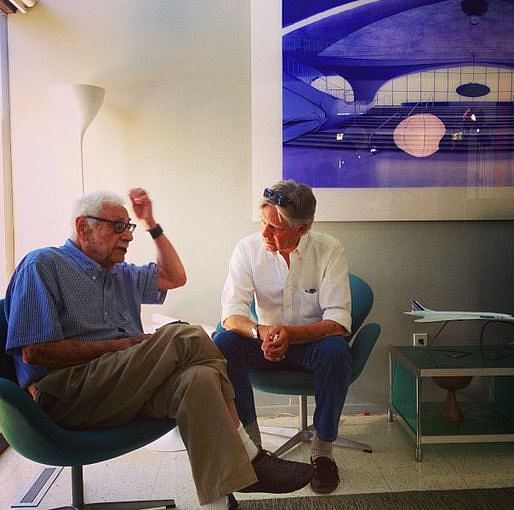
One of the biggest highlights of my experience at the conference had to be getting a chance to meet/connect/and learn from William Krisel. To be honest, prior to attending the conference I knew little of Krisel’s work other than the signature butterfly roof. However, I did know that he was one of the keynote’s and that we would be visiting many of his projects throughout the conference.

USC Class of 1998 and USC Class of 1949!
It was to my great surprise and pleasure that Will actually approached me at the opening reception of the conference. Will had read my bio/profile which the Committee on Design and distributed on the 2013 Knowledge Scholars and Will had taken the time to do his homework. He introduced himself as a fellow USC alumnus and did so in Mandarin! Apparently, Bill was born in Shanghai and grew up speaking fluent Mandarin. He was even stationed in China during World War 2 as a translator.

Bill sharing his experiences with Michael Stern
In any case, Bill was truly a spark and an inspiration as he was more than happy to share his insights and experiences regarding both architecture and life. He was the architect, landscape architect, and graphic designer of more than 400,000 housing units and 200,000 hotel units and truly left an inspiring modernist legacy behind.

Bill's signatures...the butterfly roof and the twin palms...(photo by Takashi Yanai)

Bill in convsersation with Jim Jennings (photo credit to Megan Lawler)
Modernism as a language, not a style.
As Bill adamantly proclaimed, Modernism is not a style, but rather a language. As one of the inventor’s of that language, Bill mastered it on many levels. Bill studied at USC when post and beam construction was being explored as a novel construction method. He embraced this technique whole-heartedly and not only explored it as a spatial and aesthetic device, but also as a modular assembly and fabrication technique. And not only did he explore this language as an architect, but also as the landscape architect and graphic designer for all of his projects.

Pre-pre-fab
With identical floor plans, the construction of the Twin Palms estates was expedient and efficient. All of the timber members were pre-cut, bundled and delivered to site. Quantities were fixed. There was very little waste, and no on-site cutting. As the entire development was built in the summer, the choice of wood and masonry was just as much a pragmatic decision as it was an aesthetic or performative one. In the blazing desert sun, it was impossible to lift a piece of steel in the summer! The entire development was built for $5/sf, ($8000/unit) with units selling for $13-19k.

Pre-mass customization
The entire Twin Palms development consisted of XXX units of single family homes. However there was only one floor plan, but 8 elevation variations and unlimited rotations. This allowed the economy of mass production, while enabling the richness and variety necessary to enable the character of a neighborhood. The plan is based on a 40’x40’ square layout, which gave the most interior space with the least amount of exterior skin.

The interior of Chris Menrad's home in the Twin Palms development was essentially a mid-century modern museum. Original Eames, Jacobsen, and Saarinen. Note the amazing photo of TWA.

Bill in a filmed conversation with Leo Marmol, Jim Jennings, and Stephen Ehrlich (photo by Takashi Yanai)
1 Comment
Great article. I discovered Mr. Krisel's name by photocopying an original LADBS building permit way back when... during architecture school. I had no idea who he was; however, the cookie-cutter house I grew up in was obviously special. My father photographed many different views of it in around the late 1950s to early 1960s... and beyond. Several years ago, I had the opportunity to hear Mr. Krisel... about his fascinating work through the many years. Afterwards, I had a brief moment to speak to him about the house my family once resided in for 40 years... only to be disappointed. Unfortunately, he did not acknowledge it as his own work... even though the particular project is filed in the Getty archives.
Block this user
Are you sure you want to block this user and hide all related comments throughout the site?
Archinect
This is your first comment on Archinect. Your comment will be visible once approved.